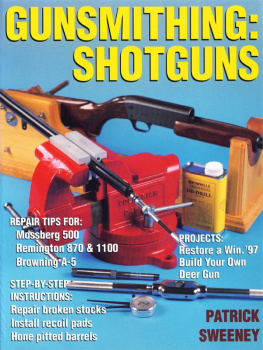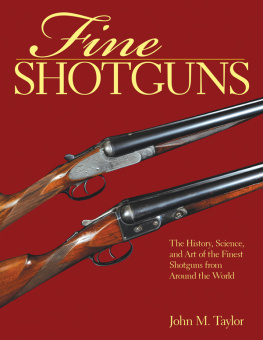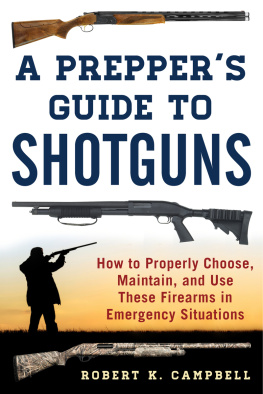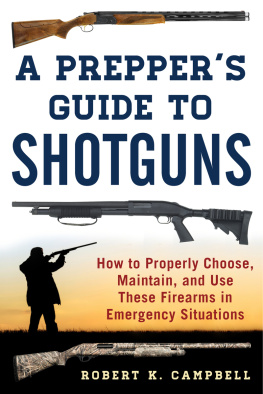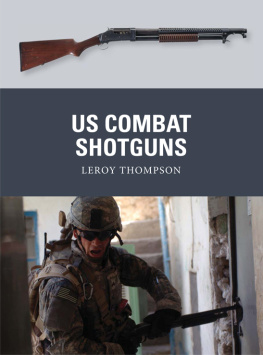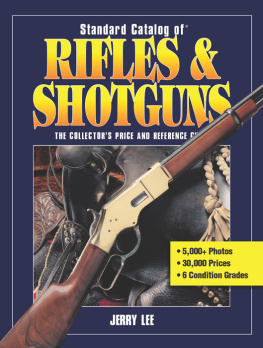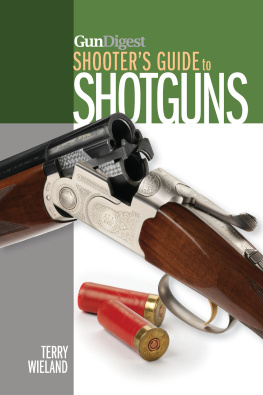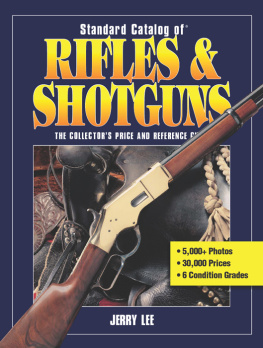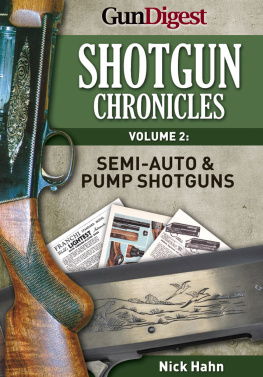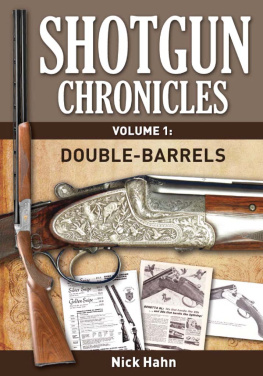Copyright 2015 by John M. Taylor
Photography by John M. Taylor
All Rights Reserved. No part of this book may be reproduced in any manner without the express written consent of the publisher, except in the case of brief excerpts in critical reviews or articles. All inquiries should be addressed to Skyhorse Publishing, 555 Eighth Avenue, Suite 903, New York, NY 10018.
Skyhorse Publishing books may be purchased in bulk at special discounts for sales promotion, corporate gifts, fund-raising, or educational purposes. Special editions can also be created to specifications. For details, contact the Special Sales Department, Skyhorse Publishing, 555 Eighth Avenue, Suite 903, New York, NY 10018 or .
www.skyhorsepublishing.com
10 9 8 7 6 5 4 3 2 1
Library of Congress Cataloging-in-Publication Data is available on file.
Cover design by Richard Rossiter
Print ISBN: 978-1-63450-315-0
Ebook ISBN: 978-1-5107-0096-3
Printed in China
To Peggy, who enjoys fine shotguns and shoots them well. Few women have visited as many shotgun factories, gunsmiths, and gun shops as she, and fewer yet say, The next new shotgun in the house is mine. She is the joy and light of my life, and without her sweet kindness, this book would never have been possible.
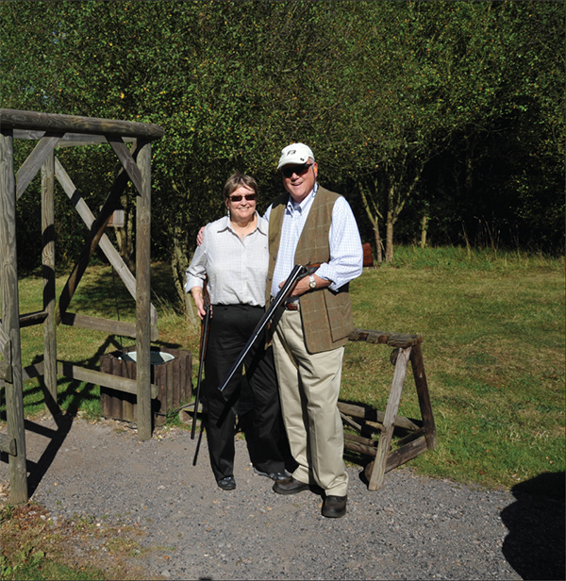
Contents

Foreword
T o build a fine rifle, a gunmaker must be a competent mechanic and have an artists eye for line and proportion. But to build a fine shotgun, it takes all that and a little black magic as well.
Rifle shooting, which is at stationary targets, is static, but all shotgun shooting is dynamic because what you shoot at is always moving. For this sort of enterprise, you need a dynamic gun, and a shotgun that does not possess that intangible mixture of balance and weight and feel that makes it an extension of your will can never be a fine shotgun. British shooters, who have studied shotgunning as intensively as anyone, call such firearms numb, as in no feeling, unable to respond.
They call them worse, too. Many years ago I had a coaching session with Holland & Hollands great shooting instructor Rex Gage. The only decent shotgun I owned at the time was an American-made over/under that had found great favor among trap and skeet shooters because it weighed a ton, and once you got it swinging you couldnt stop it.
When I pulled it out of the case, Gages face fell.
Oh my dear chap, he said, youre not going to hit a thing with that dreadful club.
He was right, and out of sympathy he loaned me a Holland shotgun for the lesson.
A skilled rifle shot can pick up almost any good rifle and do about as well with it as he can with any other good rifle. But a skilled shotgun shooter will always shoot best with one particular gun. After long (and usually costly) experimentation, he will have found that shotgun which, by its unique combination of fit, balance, weight, and sight picture, and unknown voodoo, lets him shoot better than anything else.
As Gene Hill, a formidable shotgun shooter, once told me in his mushy mumble:
David, my lad, if you ever find a shotgun that really fits, shoot the thing until it falls apart in your hands.
That one magic gun is more than likely to be a fine one.
And there are other benefits.
In the early 1970s, when I shot ATA trap seriously, I used a highly popular semi-auto gas gun. It threw lovely patterns, and was very unpunishing to shoot, but it broke so often that I eventually owned three. One I shot; one was kept in the trunk of my car to replace the one I was shooting when it broke, and one was always at the gunsmith being repaired.
In 1985 I got tired of this and bought a Perazzi MX-3, through which I have poured ammunition for 25 years. It has never broken or hollered for mercy in any form. Fine shotguns will do this. They go on and on unfailingly. Its one of the things that you spend all that money for.
A word or two about engraving and inlaying, since they are an intrinsic part of most fine shotguns. Much of what you see ranges from ghastly to unspeakable, and even expensive guns can be blighted by rotten work. Winchester Model 21s, in particular, are often afflicted with gold inlay work that looks like I did it. There are comparatively few artists who have really mastered this art, and their work is very expensive.
Two kinds of shooters can get away with engraved guns: very rich shooters (because the very rich can get away with nearly anything) and very competent shooters. Going back to my trapshooting days, there was a fellow on our circuit who owned a Ljutic (pronounced loo-tic) with a colossal gold inlay on the receiver flat. When the sun shone on it you could see the thing from the far end of the trap line. Normally, this massive mound of gold would have subjected him to mockery, scorn, and derision, except that he was a sensational shooter, and when he showed up everyone else suddenly remembered they had to mow their lawns. No one laughed at his gold blob, or at him.
My favorite inlay consists of neat gold lettering on the rear face of the barrels of a London Best live-pigeon gun that I examined 20 years ago. The letters said:
Kill it, dumbass.
I dont think this gun was built for a British shooter.
Now, a word or two about this book. It is a damned good one, but it cant make you an expert on fine shotguns. That takes, quite literally, a good chunk of your life, tons of shooting, and a chance to learn from people who have all sorts of arcane knowledge. At a Safari Club International convention, at the Fabbri booth, I once listened in awe as the gentleman who ran it delivered a lecture on how to detect non-factory modifications on Fabbris. It revealed a depth of knowledge that I didnt dream of.
There is also opinion in these pages. For example, Mr. Taylor states that his Perazzi Sporting model is not a fine shotgun. I happen to own one, and think that not only is Mr. Taylor wrong, but that he actually deserves a beating for saying such a thing. Nor do I see a chapter devoted to the Italian firm of Fratelli Piotti, which makes guns of heart-wrenching loveliness and Herculean strength, but there is a chapter on Siace, of which I have barely heard.
But then John Taylor is the expert and I am not. If I were, I would have written it. In any event, it is a damned good book and a very useful one, and when you finish it you will know worlds more than you did when you started.
Also, youll enjoy it. I know I did.
David E. Petzal,
Field Editor, Field & Stream
June 12, 2010
Acknowledgments
A book such as this could not have been written without the help of many friends and professional acquaintances. My wife, Peggy, has been a constant source of inspiration, and the occasional gentle nudge when the pace of work slackened.
It would be impossible to categorize all the help and advice Ive received during the production of this book, but certainly Catherine Williams, the former communications manager of Beretta USA, was instrumental in allowing me to tour the Beretta manufacturing facilities in Gardone Val Trompia, Italy. The tour not only provided insights into the modern manufacturing processes of high-grade shotguns, but afforded me the opportunity to take many of the photos you will see herein. In addition, Jarno Antonelli and Guisy Di Dio of Beretta Italia provided excellent translations of all my many questions, and also knew of every wonderful restaurant along the way. Dr. Ugo Gussalli Beretta was a wonderful, warm host, both at the Beretta factory and at his familys historic home.









